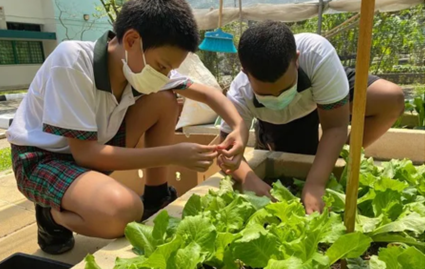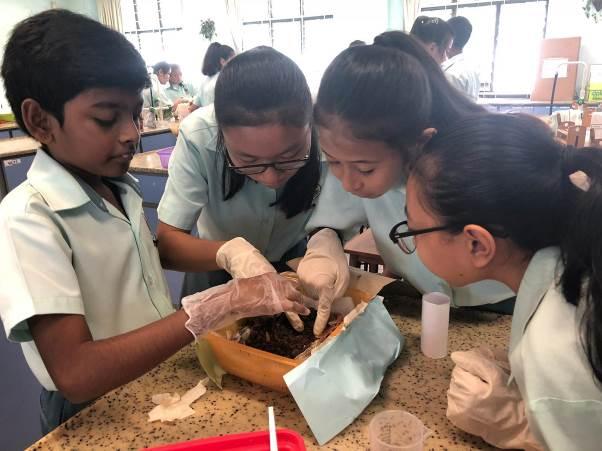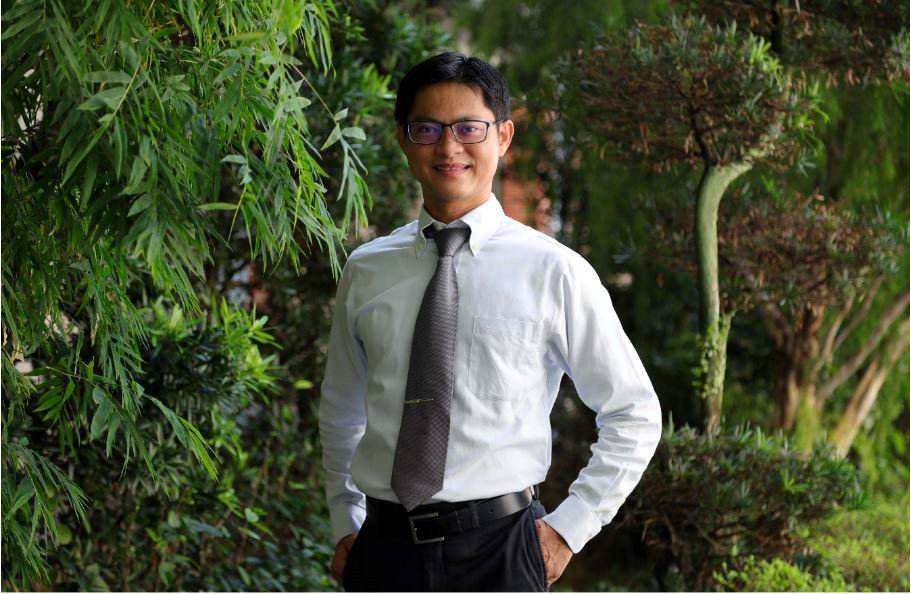You might have heard about Singapore’s ’30 by 30’ initiative. It’s the country’s effort to build up our capability and capacity to produce 30% of our nutritional needs by 2030.
What part do students play in this?
Plenty, say the professionals at the National Institute of Education (NIE). Understanding Singapore’s vulnerable position when it comes to our food sources could inspire them to come up with creative solutions on how to produce our own food. This will bode well for their learning and contributions to Science, Technology, Engineering and Mathematics (STEM).
With this premise in mind, NIE organised the Empowering STEM Education Professionals Programme (ESEPP) last year. The challenge was for teachers to design a 12-week lesson package related to the theme of Edible Landscapes, integrating at least two subject disciplines such as Maths, Science, Humanities, or even the Languages.
“It provides opportunities for students to make connections between different disciplines. They also learn to generate innovative solutions that can be applied in real-world scenarios. We will continue to share these lesson ideas with the community of educators who are keen on integrated STEM learning,” says Ms Winnie Liang of Cedar Girls’ Secondary.
Three winning teams – from Madrasah Irsyad Zuhri Al-Islamiah (primary school category), Peirce Secondary and a combined group from Cedar Girls Secondary and Dunman Secondary School – talk about the impact of their lesson packages on their students.
Madrasah Irsyad Zuhri Al-Islamiah
How can we contribute to the supply of vegetables for the canteen vendors?
At the Madrasah Irsyad Zuhri Al-Islamiah, each Primary 4 class was assigned an edible class garden. The goal? To harvest the vegetables for canteen vendors.
Students were eager to start the challenge, excited at the prospect to grow their own edible plants. To understand why they were embarking on the project of harvesting, students were introduced to the topic of food sustainability and why this is important to Singapore.
Science teachers then taught students to identify different plants, including different plant parts. They also learnt basic gardening skills such as planting and how germination works.
.jpg) A learning centre was set up to showcase a variety of plants, and what students can expect to see after sowing the seeds and stems.
A learning centre was set up to showcase a variety of plants, and what students can expect to see after sowing the seeds and stems.
An engineering component was also introduced where students designed self-watering containers, and landscaping skills came into play when they created a blueprint of the proposed layout of their edible garden.
They were also guided on various types of farming, such as aquaponics, hydroponics, and vertical farming, which they recorded in their journal. This research gave them insights into the best types of farming to resolve the problem, including the option to combine farming types.
By charting their plant growth on Google sheets during ICT lessons, students were also given hands-on experience to meaningfully present authentic data.
.jpg) A self-watering system designed by students using an inverted plastic bottle.
A self-watering system designed by students using an inverted plastic bottle.
“While tending to the edible class garden, some groups were over-zealous in watering the plants, which did not survive as a result,” says Ms Nurul Iffa Omar, a Science teacher who was part of the team. They were discouraged by that, or if other stems and seeds they planted took a while to germinate. This gave them a deeper appreciation of the journey from farm to fork, while also learning values such as perseverance and patience.”
“It was heartwarming to see students grow in excitement over the 12 weeks. It was not uncommon for them to ask their Science teachers, after class ended, for pointers on how they could improve the outcome of this project. During English lessons, teachers encouraged students to organise and express their planting experience coherently and expressively,” she adds.
“Students had a countdown to harvest day and could not stop talking about it. Beyond the bountiful harvest, we are glad that this experience helped them integrate knowledge and skills from various subjects, and promoted a sense of inquiry through investigative work!”
Peirce Secondary School
How can we increase the yields of vertical farms?
At Peirce Secondary School, students are no stranger to green spaces in their school, which houses a Sky Garden and walls of vertical plant shelves. These shelves cannot be missed – they line the school corridors, laden with plants that offer cooling shade from the sun. These plants can also be harvested for consumption.
For the ESEPP challenge, Science teacher Ng Bing Fu posed this question to the Secondary 2 students: What can we do to improve the design of vertical farms, particularly to increase production yield?
 Students tend to the plants on the many shelves that line the school corridors.
Students tend to the plants on the many shelves that line the school corridors.
Working in groups of five, students sought to develop a vertical farming solution which produces the highest yield of crop per unit land area. They began by watching videos about smart farming in Singapore, and how the use of artificial intelligence optimises growth conditions for crops.
They soon came to realise that there was much to consider: from the design of the vertical farm, to the placement of the prototype, even the amount of soil their design requires.
.jpg) Design of vertical farming prototype produced by the students during their brainstorming phase
Design of vertical farming prototype produced by the students during their brainstorming phase
These factors would have an impact on the cost-effectiveness of their design, as each pack of soil would cost 5% of the team’s profit. What’s more, the placement of the team’s prototype would also be determined through a bidding system, where the highest bidder would have first dibs on the location. These ‘costs’ would factor into the tabulation of results, which takes into consideration team’s spending and farming output.
During Science lessons, students were given basic materials to build preliminary versions of their designs. Some students considered designing a water collection system to minimise water wastage. Maths teachers also guided students on the use of various mathematical models on the calculation of profit and loss in the running of their vertical farms.

The team’s vertical farming prototype in action, which was placed directly under the sun for maximum rate of photosynthesis for a potentially higher yield.
“By engaging in the STEM task, students also appreciate the discipline of Science as a way of thinking and doing,” says Mr Ng. For example, students must conduct experiments to test their prototype design before they interpret data and begin construction of the vertical garden.
“Time is set aside for tinkering and self-directed learning. These elements of maker education encourage creativity and curiosity. These are skills that students can carry with them long after the completion of this project.”
Cedar Girls’ Secondary and Dunman Secondary
How do the different perspectives surrounding food security for Singapore affect our farming plans?
A conversation between two teachers from Cedar Girls’ Secondary and Dunman Secondary resulted in a combined team entry for the ESEPP challenge, where the lesson plan could be enacted in both schools.
The teachers wanted to help their students to better address Singapore’s food security challenges by adopting different perspectives on the issue.
In their lesson plan, students were asked to consider the feasibility of the ’30 by 30’ initiative from the viewpoint of an aspiring urban farmer, the government, a middle-income Singaporean, and a local vegetable supplier.
The students researched about how the ’30 by 30’ food production target would affect the lives of their assigned stakeholder. By reading comments from netizens and news articles, and interviewing family members and local stallholders, they became more aware of the complexities of the food target. It wasn’t a simple case of just growing more vegetables.
“For example, students found out that Singaporeans are aware that local produce is fresher, and contributes to the local economy. But buyers balk at the price tag which is up to 20 per cent more than imported produce,” explains Ms Winnie Liang, who was part of the team from Cedar Girls’ Secondary.
To add on the historical perspective, during History and Social Studies lessons, teachers underscored the importance of self-reliance by highlighting Singapore’s experience during the Japanese Occupation. More recently, the topic of food disruptions caused by the Covid-19 situation came up in class too.
The students then linked their learning back to their design of an edible landscape in school. For example, they discussed how they could choose vegetables for a plot size and location that a farmer will still profit from, at a price that buyers are willing to pay.
“This helped students understand the challenges of determining what is good for a society because of competing interests, as trade-offs have to be made in managing these interests. The project nudged them to consider general criteria in decision-making such as costs, acceptance, resources, time and space,” says Ms Liang.




.jpg)

